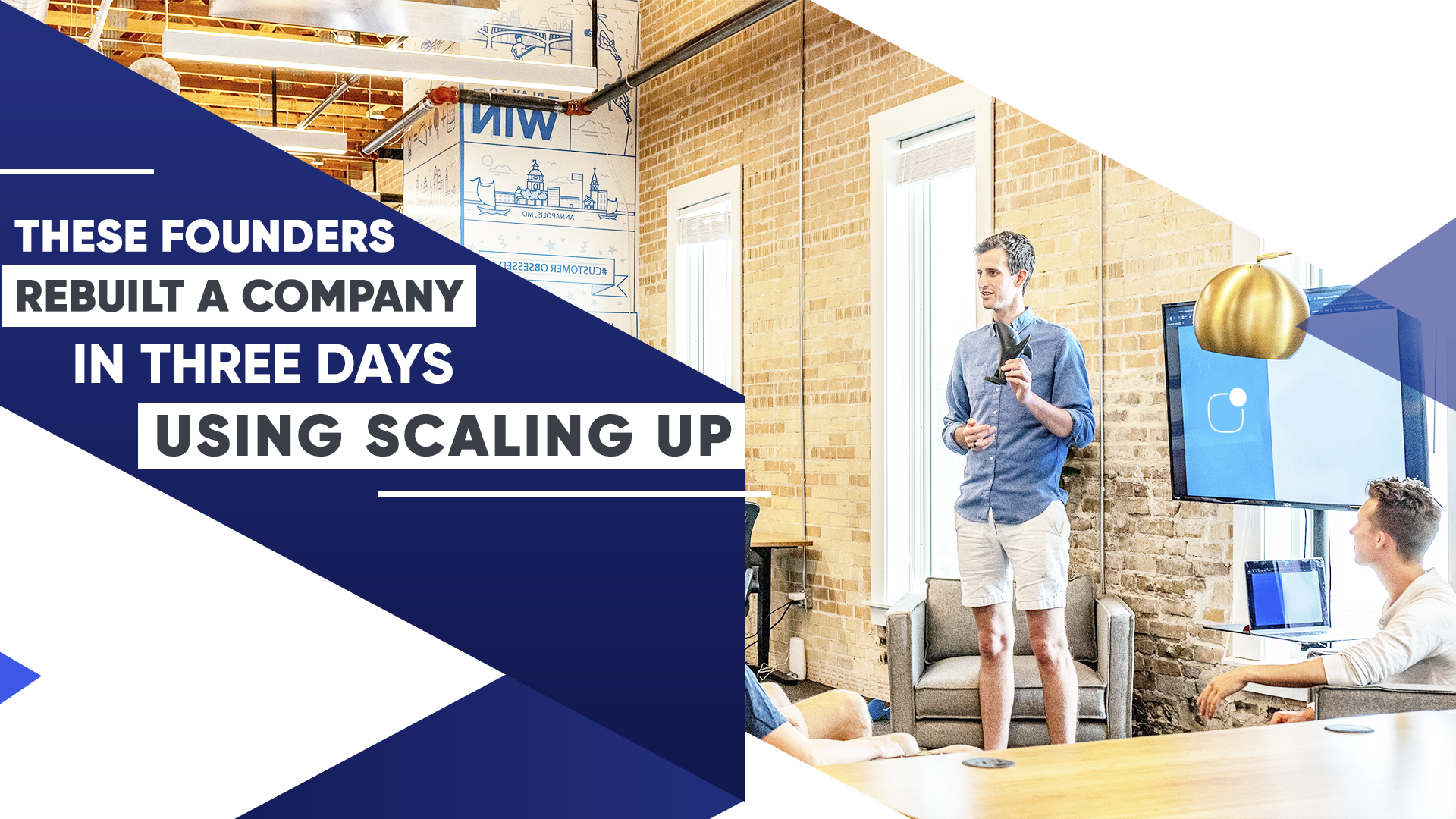The Ultimate Guide To Complete A One-Page Strategic Plan – Your Fast-Track To Alignment
%2016.55.51.png)
To get the most out of this article, download the One-Page Strategic Plan (OPSP) template now. This will allow you to follow along and start filling it out as you learn about its key components.
📥 [Download the OPSP Template Here]
By the end, you’ll have a clear, structured plan to align your team and accelerate your company’s growth.
Now, let’s dive in!
The faster my company grows and the more team members we add, the more problems I see pop up around communication and alignment.
If you’re running a fast-growing company, I’m positive that you can relate. And at this point you’re probably asking yourself what I used to ask all the time early on in my career: how do I get everyone on the same page and execute smoothly?
This is a document that I not only recommend to my clients, it’s something that I’ve been using to scale my companies over the past 19 years.
Scale your impact and reduce the drama
At Growth Institute, we help mid-market companies do two things: scale their impact and reduce the drama.
And we practice what we preach. Being an Inc. 5000 company over the past two years, we understand
the challenges fast-growers face and we use the tools that we suggest ourselves too. We know the impact they have – not just in theory but also from our own experience.
I got together with Scaling Up coaches Ann Ralston, Jonathon Herps, and Mark Miller to walk through how the OPSP works – and how you can build one to scale up in the next year.
These expert practitioners of the Scaling Up methodology gave a peek into how much thought and attention it takes to fill out the OPSP. Here’s a summary of all the useful knowledge we covered.
If you’d like to follow along and take notes, you can download your own OPSP template here.
Important note before you start: don’t beat yourself up if you don’t get it all done in one go. You can iterate. The OPSP is meant to be a living document, not something set in stone.
The OPSP in short
Who’s gonna do what, by when, and how do we measure that?
The One-Page Strategic Plan contains three main elements in regards to your business: the cards you’re dealt, how you’re gonna play them, and the outcome you expect from your game.
It’s based on the 4 Key Decisions model of Verne Harnish’s Scaling Up methodology, which when done right, helps you laser-focus and scale up.
The 4 key decisions are around strategy, people, execution, and cash:
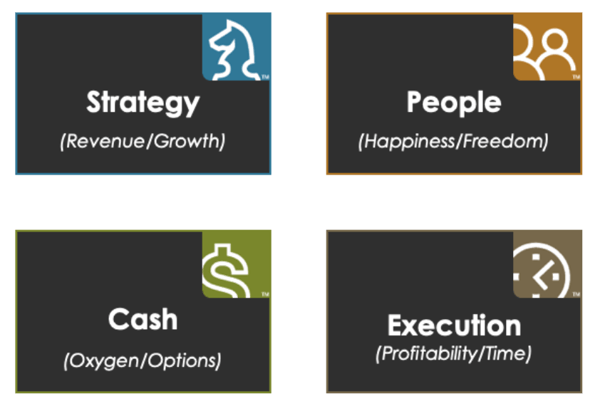
-
Strategy
The effectiveness of your strategy is reflected in your growth and revenue. If your strategy is working well, that’s where you can tell. In order to be on track here, you have to be growing at least twice as much as the rest of the industry is doing.
-
People
The success you’re having on the people front is reflected in the happiness and freedom found in your team. You need to have fun, help, and respect each other. Are you having a good time with your people? And can you take your annual holiday leave without constantly being interrupted? If so, you’re doing well in this area.
-
Execution
The potency of your execution is reflected in your profitability and the amount of time you spend working. Is your profit less than industry average or do you work 18 hours a day? If yes, you’re having an execution problem.
-
Cash
The problems you may experience is the area of cash are merely symptoms of an underlying “disease” or dysfunction. If you have a problem in any of the other areas, it’s reflected in your cash flow.
The One-Page Strategic Plan brings all of these areas together.
How is the OPSP built?
The OPSP consists of three sections:
- At the bottom you find your starting point or foundation,
- In the middle is what you’re going to build,
- And on top are results you’re headed towards.
- Your “why” - the starting point or foundation at the bottom plus the values and purpose you’ve got with your company on the left;
- Your targets and goals or your “what” on the top and in the middle;
- Your execution or your “how” on the right.
As we go through the strategic plan section by section, I will summarize the breakdown from the perspective of the three Scaling Up coaches who I ran the workshop with.
The core was explained by Jonathan Herps, the “what” was explained by Mark Miller, and Ann Ralston finished us off with her teachings of the “how”.
Let's dive in.
The core of the OPSP: your “why”
Explained by Jonathan Herps
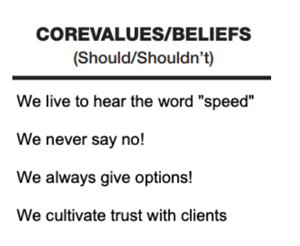
At the core of the One-Page Strategic Plan you describe your company’s values and purpose. All else stems from this. Here is what Jonathan had to say about this section.
Defining your core values When you’re defining your company’s core values, a great way to look at it is as if you were a parent: what would be the main things you’d want to impose on your “children?” What are the things they should and shouldn’t do?
Knowing and clearly communicating your values is vital because they will help individual team members make better decisions. Especially when they’re faced with ethical or moral dilemmas.
Below you can see a great example of core values by Atlassian:

As Scaling Up coach Jonathan Herps explained during the workshop, it’s essential not to set any of these in stone but to try them on first. Then you can assess which work best and are most critical to your organization and which may need some fine-tuning.
 Articulating your purpose
Articulating your purpose
Your purpose or mission provides the critical why behind everything that you do. It’s the one definitive statement that drives the business. And having a clearly defined purpose matters. A list of the world’s 50 fastest growing brands revealed the effect. Brands that serve a clear purpose experience 400% more profitability than those who don’t.
Jonathan shared, “For millennials we found it’s particularly important to know what they’re investing their creative energy in. It keeps them sticking around a lot longer.”
To articulate your purpose, start by answering these questions:
- What makes us matter and what would happen if we weren’t there?
- What difference is our company making in the world?
What are your company’s strengths and weaknesses and the (global) trends?
Although this part of the OPSP seems similar to the traditional SWOT, we invite you to look further than you would with that model. When looking at trends, we’re not just talking about industry or region specific trends. We’re also looking out for global ones. The emergence of certain technologies and various social or political trends are the kinds of global events that might affect your business - so it’s important to keep your eye on them.
%20(1).png?width=864&name=Zrzut%20ekranu%202019-12-13%20o%2016.03.37%20(1)%20(1).png)
To come up with your inherent strengths and weaknesses, focus on what has and what hasn’t been working well in the past and what you’re experiencing right now. When defining your weaknesses, think about the parts that are unlikely to change.
Strategy section part 1 – your “what”
Explained by Mark Miller
Now that you’ve defined your “why” it’s time to define your “what” – the specific long-term, mid-term, and short-term goals you want to hit in order to fulfill your purpose. Here, I will summarize the teachings from Mark Miller.
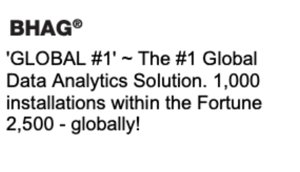 Big Hairy Audacious Goal (BHAG)
Big Hairy Audacious Goal (BHAG)
Your BHAG is your envisioned future. This is where you answer the question of what you want to achieve in the next 10 to 30 years. Your BHAG is your “Mount Everest” or “Northern star” and should be about 70% realistic and 30% unnerving. It needs to be bold enough to stretch the limits of your capabilities.
When setting long term goals, one of the biggest mistakes that I see business leaders make is that they focus only on what they expect is going to change due to their existence. But it’s important to take into consideration what is not going to change as well.
To give you an example: a client selling shoes once asked if we could help them increase the amount of stores they were selling from.
To the client, this seemed like a reasonable goal, however, we strongly advised against pursuing it, unless they’d like to go bankrupt faster.
If your goal is to build more stores, you’re focusing on the process, and not on the underlying never-changing need – in this case: people that want to buy shoes. How people will buy the shoes might change in the future but they will still want shoes. It’s important to consider the consistent need for your BHAG.
There are 4 types of BHAGs you can use:
- the target type, focused around a certain numeric goal,
- the role model type, e.g. becoming the “Nike” in a different industry than sports clothing,
- the competitive type, e.g. surpassing your biggest competitor by X,
- or the transformational BHAG, where you focus on transforming your industry.
Whichever type you choose, it should be aligned with your core purpose. Your BHAG simply wants more of what your purpose states.
 3 to 5-year target
3 to 5-year target
In the 3 to 5-year target you will create a quantitative goal, reverse-engineered based on your BHAG. Narrow in and establish what your basecamp looks like if you want to reach your BHAG.
Sandbox
This is simply defined as the market are in which you are choosing to compete in. Here you are going to briefly describe the core customer (who and where) and what it is you plan to sell them over your 3 to 5-year target.
In which areas do you want to be #1 in the world in? The sandbox describes exactly what you’re going to serve your customers and helps you get more clear on what you’re going to say “no” to.
 Brand promise and brand promise KPIs
Brand promise and brand promise KPIs
Your brand promise is what you want to be known for by your customers. It’s what is going to drive your core customer to you and focuses on their needs, not per se their wants.
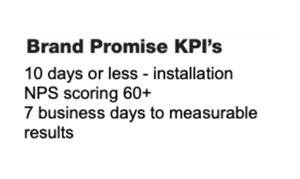
Brand promises and brand promise KPIs form the linkage between strategy and execution.
How are you going to differentiate?
Like Mark suggested in the webinar, it’s a good idea to create one primary and two supporting brand promises. E.g. “speed of installation,” “easy to do business with,” and “results in a week.”
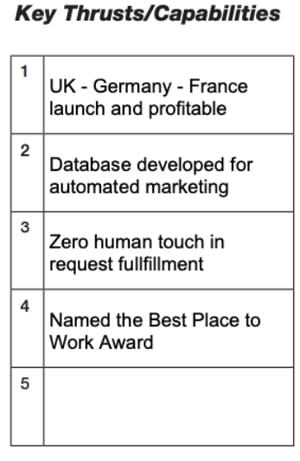 It needs to be defined in a concise way so you can create measurable KPIs for those promises. In this example the promises could turn into the following KPIs: “10 days or less - installation,” “NPS scoring 60+,” “7 business days to measurable results.”
It needs to be defined in a concise way so you can create measurable KPIs for those promises. In this example the promises could turn into the following KPIs: “10 days or less - installation,” “NPS scoring 60+,” “7 business days to measurable results.”
Key thrusts/capabilities
Your key thrusts and capabilities affirm and support your market positioning so you can achieve your brand promise KPIs. They are measurable subgoals that help you stay on the right track.
You can also look at them as your medium-term priorities.
Strategy section part 2 – the “how”
Explained by Ann Ralston
%20(1).png?width=864&name=Zrzut%20ekranu%202019-12-13%20o%2015.19.20%20(1)%20(1).png)
In the third section you’re getting even more specific and move from the “what” of your strategy to the “how.” Here, we create the metrics that help us know if we’re on track. In the workshop Ann Ralston helped us understand how we turn our vision into action.
1 year
In your 1 year target goal you can set profit goals, impact goals, customer NPS goals or even employee NPS goals, depending on your business. You should define measurable numbers here so you can move easily from strategy to execution.
Key initiatives
In the key initiatives box you fill in the most important 3-5 key initiatives for this year to ensure you reach your 1 year goals. It’s important not to come up with more than 5 initiatives – otherwise you and your team will lose focus. Or as Ann put it: “if you try and do everything, you do 6 or 7 or 8, you probably won’t do a really good job at any one – and you’ll confuse the heck out of your employees.”
Critical numbers
In the critical numbers section you define the leading indicators that show whether you’re on or off-track. Leading indicators are defined in ways that are input and/or action oriented. If you’re reporting on sales numbers for instance, a lagging indicator is the actual amount of sales or revenue. A leading indicator then, could be the number of sales calls per representative or the number of sales emails sent.
When reporting on critical numbers, use two numbers that balance each other out, otherwise you might get a skewed picture of how your business is doing.
For example, if you’re reporting on the number of sales calls but neglect the customer satisfaction indicator, you may jump to false conclusions. Although your number of sales might be strongly increasing, your company could still be in danger of going out of business if the new sales approach leads to a strong decrease in customer satisfaction.
Annual/quarterly theme
The themes are the fun part of the OPSP. This is where you can get creative and select which annual or quarterly themes are considered cause for celebration once you hit them.
And once you hit the goal for your theme, how are you gonna celebrate it with them?
Make sure that you visualize the progress along the way and create a scoreboard design sketch.
Coach Ann Ralston gave a great example during the webinar. If the goal for your theme is to hit 1200 customer visits, you can draw a mountain with a flag on top with the number on it. The sketch should give you some ideas on how to create a physical presentation of your progress that will be visible for everyone in the company at all times.
Another incredible example of what this can lead to, comes from our client Proof. They used a theme to hit their company’s 50K MRR goal and surpassed it faster than they anticipated. The celebration? A company Tesla. As their founder, Dave Rogenmoser, shared in an interview about their experience with the OPSP:
“We printed this poster of 50K with cars on it and had this big monitor underneath it. And every time we would hit another thousand dollars MRR, we'd add a new line and do a little dance and celebration. It laser focused everyone on this one specific goal.”
Rocks
The rocks make your goals concrete. If you don’t accomplish them this quarter, you might never hit your annual goals. Need to accomplish a certain big task next quarter that requires a new hire, for instance? Then hiring that one employee could be one of your rocks.
As your rocks can not be missed, they’re the most important things to focus on! So get clear on them and make them numerical.
Accountability
In the accountability section you add names to your KPIs. Who is responsible for which KPI?
This makes it very clear for both individuals and teams what their main focus should be.
Recommendations for optimal implementation of your OPSP
- In large organizations each business unit could have their own OPSP based on the overall company plan. In that case, we recommend that you use software to have it digitized and not have to rely on paper versions alone.
- Once you’ve completed your OPSP, remember to keep it as a living document. The key purpose is better alignment and communication. So look at it frequently.
- We encourage teams to review their OPSP on a weekly basis to see where they are currently on or off track with their rocks and KPIs. Don’t spend time on the ones that are on track or “in the green.” You can just use this review to talk about the “reds” and “yellows;” the ones that need attention.
- When you use the OPSP like this, you’re constantly iterating on the processes that make your company really good at what it does. As a result, you and your company are learning faster. This will bring you a huge strategic advantage for 2020.
3 ways to get guidance with implementing your OPSP
It’s not completed until it’s implemented. Ready to get your entire organization on board? Here are 3 ways to implement your plan in the best way possible:
Buy the book
Buy Verne Harnish’ Scaling Up book for you and your team members and work with the tools and techniques described in detail there.
Get coaching
Get in-house coaching to help you implement the OPSP. You can work with certified coaches like Ann Ralston, Jonathan Herps, Mark Miller or any of our other 150+ partners from around the world that can help you one-on-one or on team-level.
Go for online implementation
If you want to get the most value out of the OPSP and the entire Scaling Up methodology, we encourage to join the Scaling Up Master Business Course.
You will get guidance from Verne Harnish himself and one-on-one coaching with Chuck Kocher to review every single box of your OPSP once you’ve completed it. It also entails interactive masterminds with a small group of business leaders to help each other implement the plan and bounce off ideas.
The time investment? In about 3 hours per week for 10-12 weeks you’ll be all set.
We’re keeping the groups small to ensure the highest value, so if you’re interested to join the next cohort, learn more today.



%20(1).png?width=864&name=OPSP_template_full%20(1)%20(1).png)


